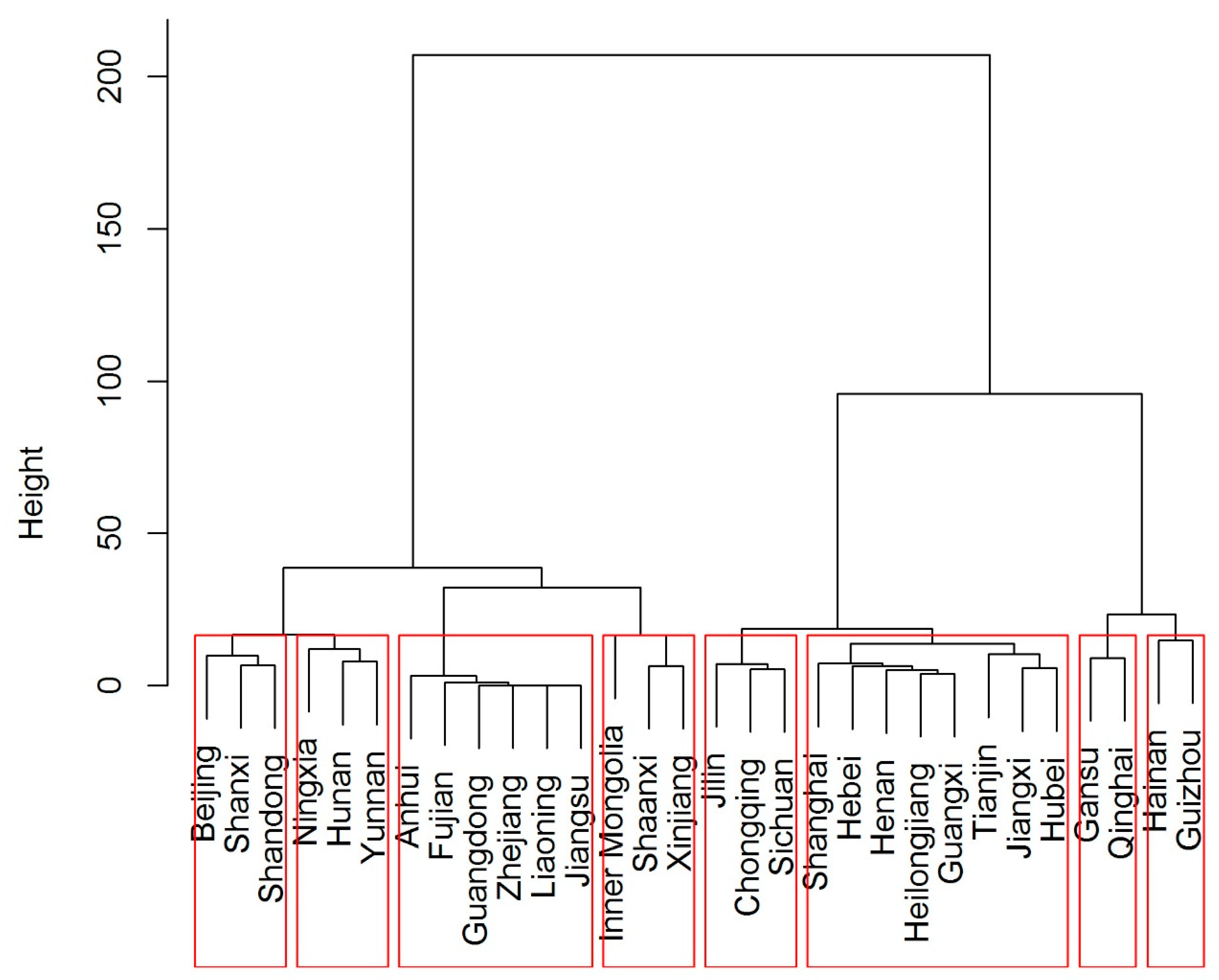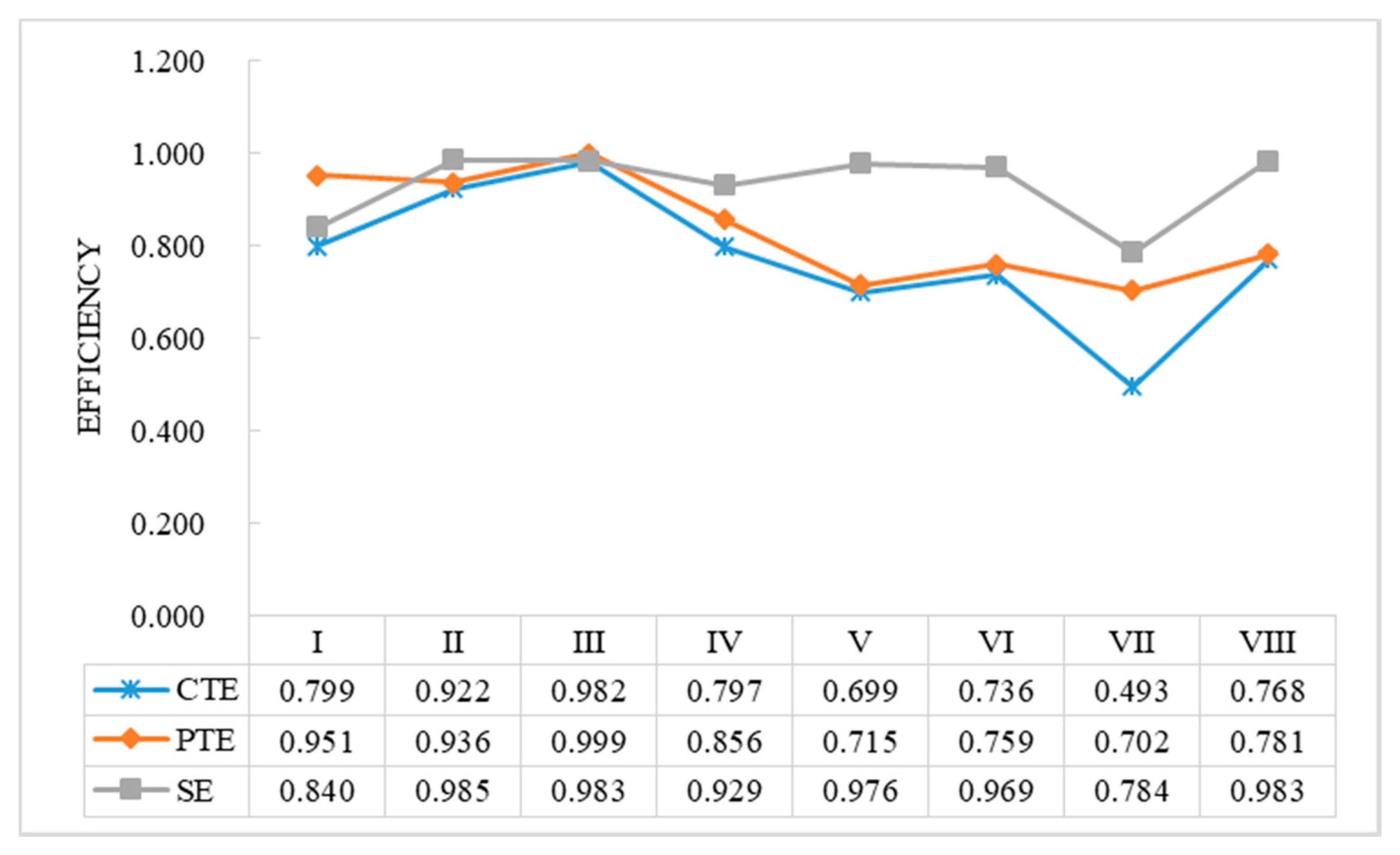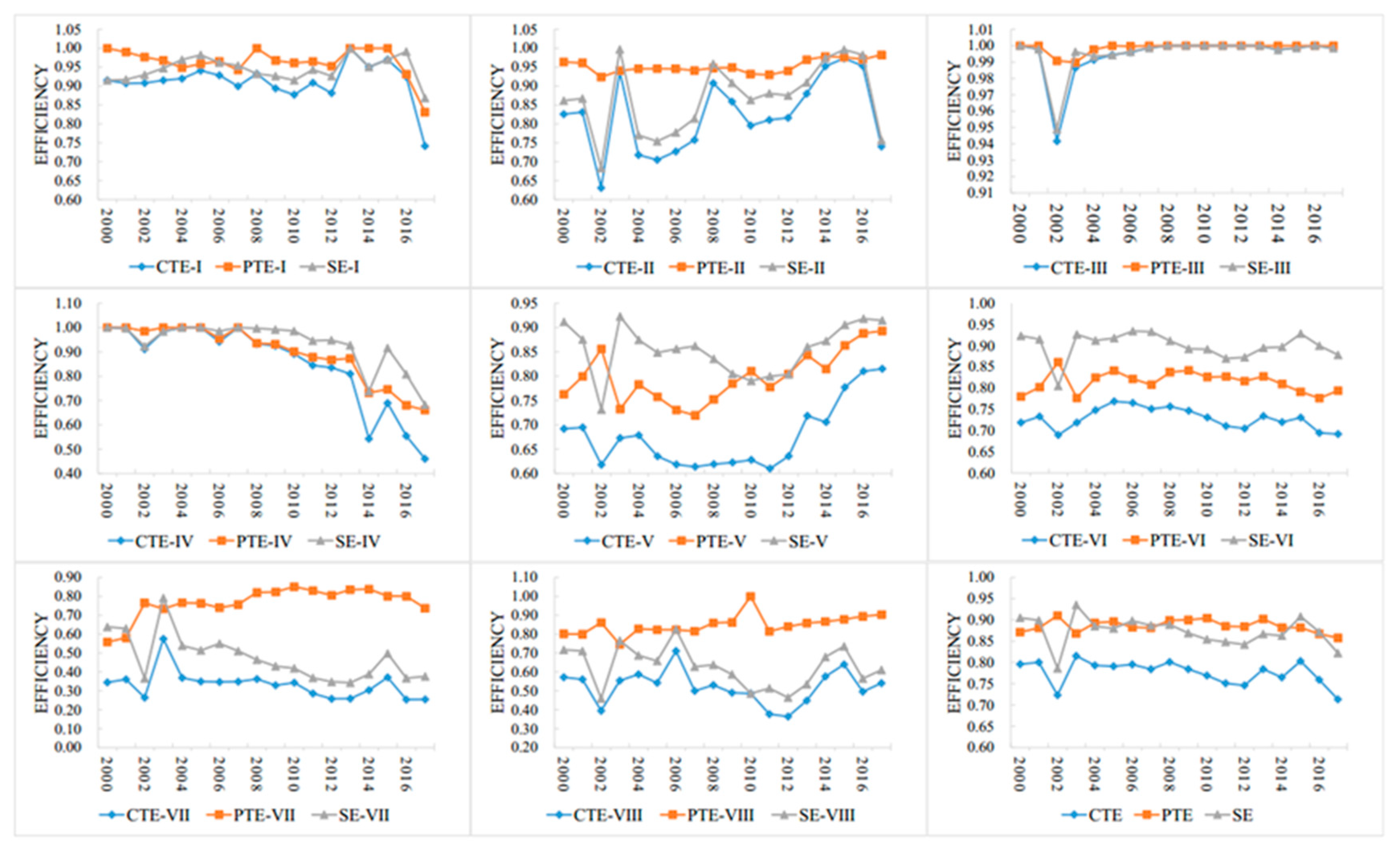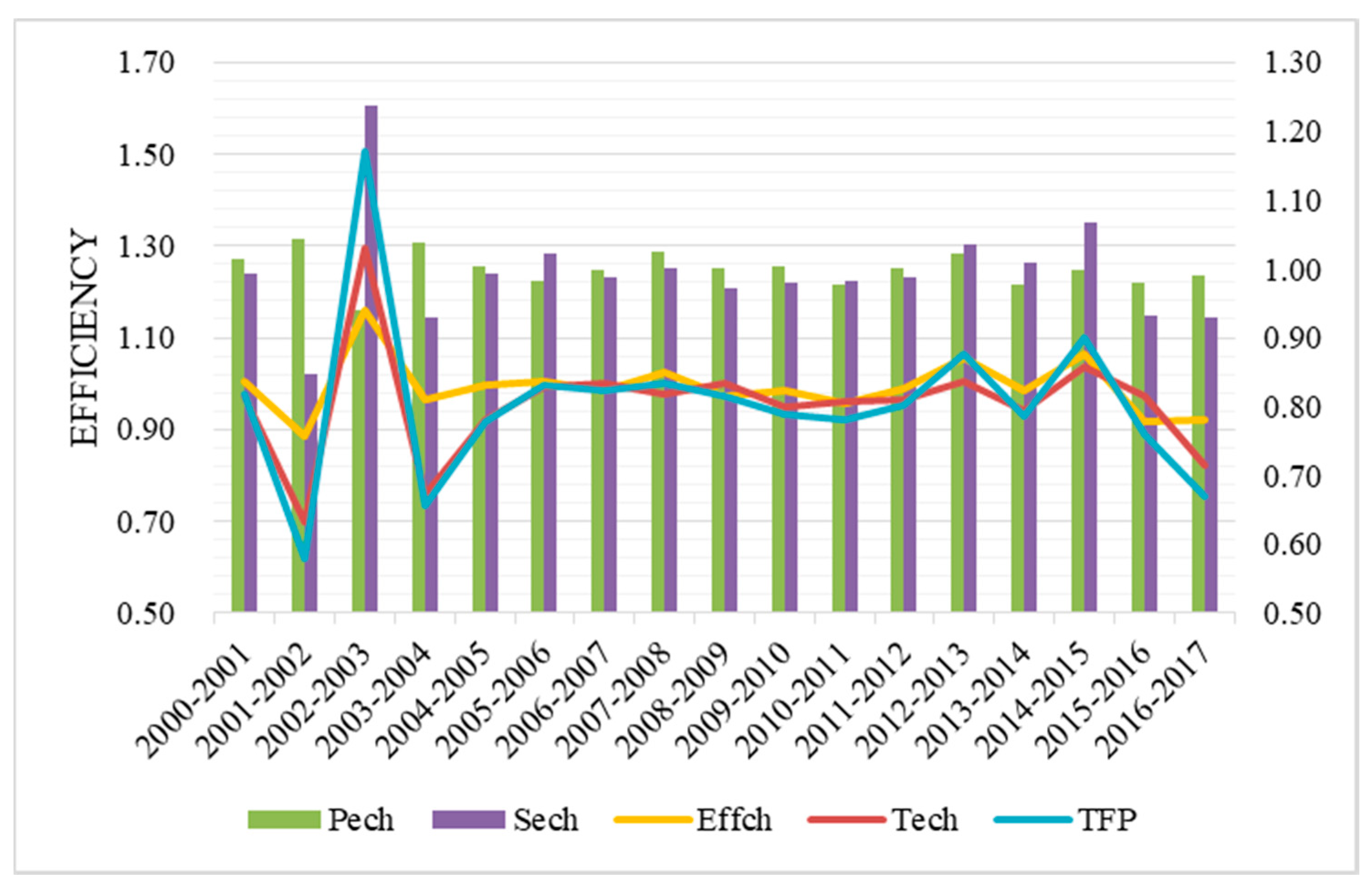Analysis and Evaluation of the Regional Characteristics of Carbon Emission Efficiency for China
Abstract
:1. Introduction
2. Literature Review
2.1. The Definition of Carbon Emission Efficiency (CEE)
2.2. Evolution of Methods to Measure CEE
2.3. Application of the Three-Stage DEA and DEA-Malmquist Model
3. Methodology
3.1. Three-Stage DEA Model
3.1.1. The First Stage: The Traditional DEA Model
3.1.2. The Second Stage: Similar Stochastic Frontier Model
3.1.3. The Third Stage: The Adjusted DEA Model
3.2. Three-Stage DEA-Malmquist Model
4. Variable Selection and Data Source
4.1. Variable Selection
4.1.1. Variables of Input and Output
4.1.2. Environmental Factor Variables
Economic Development
Industrial Structure
Energy Structure
Government Regulation
Technological Innovation
Openness
4.2. Data
5. Empirical Analysis
5.1. Static Analysis Based on the Three-Stage DEA Model
5.1.1. Results in the First Stage
5.1.2. Results in the Second Stage
5.1.3. Results in the Third Stage
5.2. Dynamic Analysis of the Three-Stage DEA-Malmquist Index Model
5.3. Econometric Analysis of CEE
6. Research Conclusions and Suggestions
6.1. Research Conclusions
6.2. Suggestions
Author Contributions
Funding
Acknowledgments
Conflicts of Interest
References
- British Petroleum (BP). BP Statistical Review of World Energy 2019 Workbook; British Petroleum: London, UK, 2019. [Google Scholar]
- Meng, F.Y.; Su, B.; Thomson, E.; Zhou, D.Q.; Zhou, P. Measuring China’s regional energy and carbon emission efficiency with DEA models: A survey. Appl. Energy 2016, 183, 1–21. [Google Scholar] [CrossRef]
- Kaya, Y.; Yokobori, K. Environment, Energy, and Economy: Strategies for Sustainability; United Nations University Press: Brussels, Belgium, 1997. [Google Scholar]
- Pretis, F.; Roser, M. Carbon dioxide emission-intensity in climate projections: Comparing the observational record to socio-economic scenarios. Energy 2017, 135, 718–725. [Google Scholar] [CrossRef] [PubMed]
- Ferreira, A.; Pinheiro, M.D.; de Brito, J.; Mateus, R. Combined carbon and energy intensity benchmarks for sustainable retail stores. Energy 2018, 165, 877–889. [Google Scholar] [CrossRef] [Green Version]
- Song, J.Z.; Yuan, X.Y.; Wang, X.P. Analysis on influencing factors of carbon emission intensity of construction industry in China. Environ. Eng. 2018, 36, 178–182. [Google Scholar]
- Hu, J.L.; Wang, S.C. Total factor energy efficiency of regions in China. Energy Policy 2006, 34, 3206–3217. [Google Scholar] [CrossRef]
- Zhou, P.; Ang, B.W.; Han, J.Y. Total factor carbon emission performance: A malmquist index analysis. Energy Econ. 2010, 32, 194–201. [Google Scholar] [CrossRef]
- Song, M.L.; An, Q.; Zhang, W.; Wang, Z.; Wu, J. Environmental efficiency evaluation based on data envelopment analysis: A review. Renew. Sustain. Energy Rev. 2012, 16, 4465–4469. [Google Scholar] [CrossRef]
- Molinos-Senante, M.; Sala-Garrido, R.; Hern andez-Sancho, F. Development and application of the Hicks-Moorsteen productivity index for the total factor productivity assessment of wastewater treatment plants. J. Clean Prod. 2016, 112, 3116–3123. [Google Scholar] [CrossRef]
- Zaim, O.; Taskin, F. Environmental efficiency in carbon dioxide emissions in the OECD: A non-parametric approach. J. Environ. Manag. 2000, 58, 95–107. [Google Scholar] [CrossRef]
- Zofio, J.L.; Prieto, A.M. Environmental efficiency and regulatory standards: The case of CO2 emissions from OECD industries. Resour. Energy Econ. 2001, 23, 63–83. [Google Scholar] [CrossRef]
- Wang, Z.X.; Ye, D.J.; Zheng, H.H.; Lv, C.Y. The influence of market reform on the CO2 emission efficiency of China. J. Clean Prod. 2019, 225, 236–247. [Google Scholar] [CrossRef]
- Dong, F.; Long, R.Y.; Bian, Z.F.; Xu, X.H.; Yu, B.L.; Wang, Y. Applying a Ruggiero three-stage super-efficiency DEA model to gauge regional carbon emission efficiency: Evidence from China. Nat. Hazards 2017, 27, 1453–1468. [Google Scholar] [CrossRef]
- Tone, K. A slack-based measure of efficiency in data envelopment analysis. Eur. J. Oper. Res. 2001, 130, 498–509. [Google Scholar] [CrossRef] [Green Version]
- Choi, Y.; Zhang, N.; Zhou, P. Efficiency and abatement costs of energy-related CO2 emissions in China: A slacks-based efficiency measure. Appl. Energy 2012, 98, 198–208. [Google Scholar] [CrossRef]
- Gomez-Calvet, R.; Conesa, D.; Gomez-Calvet, A.R.; Tortosa-Ausina, E. Energy efficiency in the European Union: What can be learned from the joint application of directional distance functions and slacks-based measures? Appl. Energy 2014, 132, 137–154. [Google Scholar] [CrossRef]
- Iftikhar, Y.; He, W.; Wang, Z. Energy and CO2 emissions efficiency of major economies: A nonparametric analysis. J. Clean Prod. 2016, 139, 779–787. [Google Scholar] [CrossRef]
- Cecchini, L.; Venanzi, S.; Pierri, A.; Chiorri, M. Environmental efficiency analysis and estimation of CO2 abatement costs in dairy cattle farms in Umbria (Italy): A SBM-DEA model with undesirable output. J. Clean Prod. 2018, 197, 895–907. [Google Scholar] [CrossRef]
- Wang, Q.; Su, B.; Sun, J.; Zhou, P.; Zhou, D. Measurement and decomposition of energy-saving and emissions reduction performance in Chinese cities. Appl. Energy 2015, 151, 85–92. [Google Scholar] [CrossRef]
- Park, Y.S.; Lim, S.H.; Egilmez, G.; Szmerekovsky, J. Environmental efficiency assessment of U.S. transport sector: A slack-based data envelopment analysis approach. Transport Environ. 2018, 61, 152–164. [Google Scholar] [CrossRef] [Green Version]
- Zhou, Y.X.; Liu, W.L.; Lv, X.Y.; Chen, X.H.; Shen, M.H. Investigating interior driving factors and cross-industrial linkages of carbon emission efficiency in China’s construction industry: Based on Super-SBM DEA and GVAR model. J. Clean Prod. 2019, 241, 1–13. [Google Scholar] [CrossRef]
- Dong, F.; Li, X.H.; Long, R.Y.; Liu, X.Y. Regional carbon emission performance in China according to a stochastic frontier model. Renew. Sustain. Energy Rev. 2013, 28, 525–530. [Google Scholar] [CrossRef]
- Fried, H.O.; Lovell, C.A.K.; Schmidt, S.S.; Yaisawarng, S. Accounting for environmental effects and statistical noise in data envelopment analysis. J. Prod. Anal. 2002, 17, 121–136. [Google Scholar] [CrossRef]
- Jiang, S.R.; Tan, X.; Shi, L. Industrial air pollution emission efficiency in Beijing-Tianjin-Hebei and its surrounding areas-based on three stage DEA model. J. Arid Land Res. Environ. 2019, 33, 141–149. [Google Scholar]
- Wang, Y.; Cheng, L.W.; Wang, X.N. Financial Function Promotion and Dynamic Endogenous Club Convergence in Regional Financial Development. Oper. Res. Manag. Sci. 2019, 28, 142–156. [Google Scholar]
- Yang, C.Y.; Qi, Z.H.; Huang, W.H. Is agricultural social service conducive to the improvement of agricultural production efficiency? An empirical analysis based on three stage DEA model. J. Chin. Agric. Univ. 2018, 23, 232–244. [Google Scholar]
- Liu, Z.F.; Wang, C.H. Organic Agricultural Production Efficiency Based on a Three-stage DEA Model: A Case Study of Yang County, Shaanxi Province. Chin. J. Popul. Resour. Environ. 2015, 25, 105–112. [Google Scholar]
- Yin, J.Y.; Cao, Y.F.; Tang, B.J. Fairness of China’s provincial energy environment efficiency evaluation: Empirical analysis using a three-stage data envelopment analysis model. Nat. Hazards 2019, 95, 343–362. [Google Scholar] [CrossRef]
- Wang, Q.W.; Su, B.; Zhou, P.; Chiu, C.R. Measuring total-factor CO2 emission performance and technology gaps using a non-radial directional distance function: A modified approach. Energy Econ. 2016, 56, 475–482. [Google Scholar] [CrossRef]
- Mahmoudabadi, M.Z.; Emrouznejad, A. Comprehensive performance evaluation of banking branches: A three-stage slacks-based measure (SBM) data envelopment analysis. Int. Rev. Econ. Finance 2019, 64, 359–376. [Google Scholar] [CrossRef]
- Huang, H.F.; Wang, T. The Total-Factor Energy Efficiency of Regions in China: Based on Three-Stage SBM Model. Sustainability 2017, 9, 1664. [Google Scholar] [CrossRef] [Green Version]
- Jiang, C.B.; Li, S.F.; Li, L. Research on productive efficiencies measurement based on three-stage super DEA model: A case of Chinese road and bridge enterprises. Int. J. Comput. Sci. Math. 2017, 8, 475–493. [Google Scholar]
- Wang, Z.H.; Feng, C.; Zhang, B. An empirical analysis of China’s energy efficiency from both static and dynamic perspectives. Energy 2014, 74, 322–330. [Google Scholar] [CrossRef]
- Kortelainen, M. Dynamic environmental performance analysis: A Malmquist index approach. Ecol. Econ. 2007, 64, 701–715. [Google Scholar]
- Chen, S.B.; Feng, Y.Q.; Lin, C.R. Innovation efficiency evaluation of new and high technology industries based on DEA-Malmquist index. J. Interdiscip. Math. 2017, 20, 1497–1500. [Google Scholar] [CrossRef]
- Chen, Y.; Liu, B.S.; Shen, Y.H.; Wang, X.Q. Spatial analysis of change trend and influencing factors of total factor productivity in China’s regional construction industry. Appl. Econ. 2018, 50, 2824–2843. [Google Scholar] [CrossRef]
- Zheng, S.N.; Wang, S.Q.; Liang, Q. Total Factor Productivity and Decomposition of Fisheries Economy in Coastal Areas of the Mainland of China and Taiwan: Using the DEA-Malmquist Index. J. Coas. Res. 2019, 93, 371–380. [Google Scholar] [CrossRef]
- Sun, J.W.; Li, S.S.; Zhao, X.W. An empirical analysis on total factor productive energy efficiency of Yangtze River Delta region-based on DEA-Malmquist productivity index. Manual Eng. Environ. Eng. 2014, 84, 1003–1009. [Google Scholar]
- Sun, X. Analysis on Dynamic Changes of Efficiency of Regional Energy-saving & Emission Reduction in China. Comput. Eval. Econ. Soc. Stat. Sci. 2009, 992–996. [Google Scholar]
- Charnes, A.; Cooper, W.W.; Rhodes, E. Measuring the efficiency of decision making units. Eur. J. Oper. Res. 1978, 2, 429–444. [Google Scholar] [CrossRef]
- Banker, R.D.; Charnes, A.; Cooper, W.W. Some models for estimating technical and scale inefficiencies in data envelopment analysis. Manag. Sci. 1984, 30, 1078–1092. [Google Scholar] [CrossRef] [Green Version]
- Jondrow, J.; Lovell, C.A.K.; Materov, I.S. On the estimation of technical inefficiency in the stochastic frontier production function model. J. Econ. 1982, 19, 233–238. [Google Scholar] [CrossRef] [Green Version]
- Caves, D.W.; Christensen, L.R.; Diewert, W.E. The economic theory of index numbers and the measurement of input, output, and productivity. Econ. Soc. 1982, 50, 1393–1413. [Google Scholar] [CrossRef]
- Färe, R.; Grosskopf, S.; Norris, M. Productivity growth, technical progress and efficiency change in industrialized countries. Am. Econ. Rev. 1994, 84, 66–83. [Google Scholar]
- Chung, Y.H.; Fare, R.; Grosskopf, S. Productivity and undesirable outputs: A directional distance function approach. Microeconomics 1995, 51, 229–240. [Google Scholar] [CrossRef] [Green Version]
- Seiford, L.M.; Zhu, J. Modeling undesirable factors in efficiency evaluation. Eur. J. Oper. Res. 2002, 142, 16–20. [Google Scholar] [CrossRef]
- Shan, H.J. Reestimating the capital stock of China: 1951–2006. Quant. Tech. Econ. 2008, 10, 17–31. [Google Scholar]
- IPCC. 2006 IPCC Guidelines for National Greenhouse Gas Inventories: Volume II. Japan; The Institute for Global Environmental Strategies: Kanagawa, Japan, 2008. [Google Scholar]
- Wu, X.D.; Kumar, V. The Top Ten Algorithms in Data Mining; CRC Press: Boca Raton, FL, USA, 2009. [Google Scholar]
- Murtagh, F.; Contreras, P. Algorithms for hierarchical clustering: An overview. Wiley Interdisc. Rev. Data Mining Knowl. Discov. 2012, 2, 86–97. [Google Scholar] [CrossRef]





| Variable | Unit | Variable Description |
|---|---|---|
| Labor | 10,000 persons | Number of employed population at the end of each year. |
| Capital stock | 100 million yuan | We employ an approach proposed by Shan to estimate capital stock [48]. Capital Stock in Current Year = Capital Stock in Previous Year × (1-Depreciation rate) + Capital Formation in Current Year. |
| Energy consumption | 10,000 tons of standard coal | Total energy consumption by province in the past years. |
| GDP | 100 million yuan | Gross Domestic Product (GDP) of each region as desirable output, and then transforms into 2000 prices with a GDP deflator. |
| Carbon emissions | 10,000 tons | Carbon emissions of each region as undesirable output. Calculation formula based on 2006 IPCC Guidelines for National Greenhouse Gas Inventories (IPCC, 2006) [49]. |
| Year | I | II | III | IV | V | VI | VII | VIII |
|---|---|---|---|---|---|---|---|---|
| 2000 | 0.751 | 0.933 | 0.964 | 0.932 | 0.657 | 0.714 | 0.489 | 0.716 |
| 2001 | 0.772 | 0.901 | 0.943 | 0.901 | 0.612 | 0.711 | 0.481 | 0.709 |
| 2002 | 0.806 | 0.904 | 0.979 | 0.939 | 0.651 | 0.726 | 0.495 | 0.730 |
| 2003 | 0.827 | 0.901 | 0.996 | 0.968 | 0.643 | 0.721 | 0.551 | 0.725 |
| 2004 | 0.820 | 0.903 | 0.987 | 0.918 | 0.665 | 0.740 | 0.514 | 0.724 |
| 2005 | 0.799 | 0.903 | 0.975 | 0.888 | 0.654 | 0.761 | 0.527 | 0.746 |
| 2006 | 0.785 | 0.911 | 0.982 | 0.818 | 0.648 | 0.775 | 0.523 | 0.745 |
| 2007 | 0.788 | 0.921 | 0.984 | 0.901 | 0.651 | 0.771 | 0.530 | 0.750 |
| 2008 | 0.785 | 0.929 | 0.985 | 0.874 | 0.640 | 0.770 | 0.518 | 0.774 |
| 2009 | 0.782 | 0.939 | 0.986 | 0.872 | 0.673 | 0.777 | 0.540 | 0.772 |
| 2010 | 0.778 | 0.934 | 0.985 | 0.842 | 0.674 | 0.742 | 0.559 | 1.000 |
| 2011 | 0.815 | 0.936 | 0.987 | 0.817 | 0.677 | 0.739 | 0.551 | 0.760 |
| 2012 | 0.808 | 0.942 | 0.987 | 0.785 | 0.695 | 0.733 | 0.479 | 0.741 |
| 2013 | 0.847 | 0.956 | 0.978 | 0.693 | 0.761 | 0.720 | 0.436 | 0.780 |
| 2014 | 0.829 | 0.966 | 0.991 | 0.568 | 0.748 | 0.717 | 0.459 | 0.803 |
| 2015 | 0.854 | 0.967 | 0.999 | 0.647 | 0.801 | 0.719 | 0.454 | 0.753 |
| 2016 | 0.850 | 0.967 | 0.986 | 0.537 | 0.851 | 0.703 | 0.402 | 0.804 |
| 2017 | 0.686 | 0.787 | 0.976 | 0.446 | 0.870 | 0.702 | 0.377 | 0.802 |
| Environmental Variables | Labor Input Relaxation Value | Capital Input Relaxation Value | Energy Consumption Relaxation Value |
|---|---|---|---|
| Constant | 515.275 *** | −3681.187 *** | −972.600 *** |
| (5.535) | (−3681.187) | (−4.980) | |
| Economic development | −0.032 *** | 0.053 | 0.008 |
| (−3.862) | (0.926) | (0.349) | |
| Industrial structure | 2368.704 *** | 2061.335 *** | 2956.093 *** |
| (45.654) | (2061.335) | (14.723) | |
| Energy structure | −1065.236 *** | 961.221 *** | 862.044 |
| (−7.385) | (961.221) | (1.222) | |
| Government regulation | −2108.659 | −134.913 *** | −8341.156 *** |
| (−12.437) | (−134.913) | (−25.491) | |
| Technological innovation | 29,665.732 *** | −71,571.247 *** | 17,094.065 *** |
| (90,831.1) | (−71,571.247) | (1851.116) | |
| Openness | −150.025 | 985.370 *** | −2723.965 *** |
| (−1.268) | (985.37) | (−8.944) | |
| Sigma-squared | 884,894.070 | 10,825,113.000 | 16,757,001.000 |
| gamma | 1.000 | 1.000 | 0.997 |
| Log likelihood function | −226.387 | −263.900 | −272.774 |
| One-tail error of LR | 15.410 *** | 15.407 *** | 10.767 *** |
| Region | The First Stage of DEA | The Third Stage of DEA | ||||
|---|---|---|---|---|---|---|
| CTE | PTE | SE | CTE | PTE | SE | |
| I | 0.799 | 0.951 | 0.840 | 0.912 | 0.964 | 0.945 |
| II | 0.922 | 0.936 | 0.985 | 0.823 | 0.953 | 0.868 |
| III | 0.982 | 0.999 | 0.983 | 0.995 | 0.999 | 0.996 |
| IV | 0.797 | 0.856 | 0.929 | 0.851 | 0.897 | 0.935 |
| V | 0.699 | 0.715 | 0.976 | 0.676 | 0.798 | 0.855 |
| VI | 0.736 | 0.759 | 0.969 | 0.729 | 0.815 | 0.900 |
| VII | 0.493 | 0.702 | 0.784 | 0.332 | 0.767 | 0.475 |
| VIII | 0.768 | 0.781 | 0.983 | 0.521 | 0.848 | 0.626 |
| Mean | 0.798 | 0.847 | 0.946 | 0.776 | 0.886 | 0.873 |
| Year | I | II | III | IV | V | VI | VII | VIII |
|---|---|---|---|---|---|---|---|---|
| 2000 | 0.915 | 0.826 | 1.000 | 1.000 | 0.692 | 0.719 | 0.345 | 0.572 |
| 2001 | 0.907 | 0.831 | 0.998 | 0.998 | 0.695 | 0.733 | 0.361 | 0.561 |
| 2002 | 0.908 | 0.631 | 0.942 | 0.911 | 0.618 | 0.690 | 0.265 | 0.395 |
| 2003 | 0.915 | 0.939 | 0.987 | 0.984 | 0.673 | 0.719 | 0.576 | 0.554 |
| 2004 | 0.920 | 0.718 | 0.991 | 1.000 | 0.678 | 0.748 | 0.369 | 0.587 |
| 2005 | 0.941 | 0.705 | 0.994 | 1.000 | 0.635 | 0.769 | 0.350 | 0.543 |
| 2006 | 0.928 | 0.727 | 0.996 | 0.942 | 0.618 | 0.765 | 0.348 | 0.711 |
| 2007 | 0.900 | 0.758 | 0.999 | 1.000 | 0.614 | 0.751 | 0.349 | 0.500 |
| 2008 | 0.932 | 0.908 | 1.000 | 0.934 | 0.619 | 0.757 | 0.363 | 0.530 |
| 2009 | 0.894 | 0.859 | 1.000 | 0.926 | 0.622 | 0.747 | 0.330 | 0.491 |
| 2010 | 0.877 | 0.796 | 1.000 | 0.892 | 0.628 | 0.731 | 0.343 | 0.486 |
| 2011 | 0.909 | 0.811 | 1.000 | 0.845 | 0.610 | 0.711 | 0.287 | 0.377 |
| 2012 | 0.882 | 0.816 | 1.000 | 0.836 | 0.636 | 0.705 | 0.259 | 0.364 |
| 2013 | 1.000 | 0.880 | 1.000 | 0.810 | 0.718 | 0.734 | 0.259 | 0.449 |
| 2014 | 0.950 | 0.953 | 0.998 | 0.543 | 0.705 | 0.720 | 0.304 | 0.576 |
| 2015 | 0.970 | 0.973 | 0.999 | 0.690 | 0.777 | 0.731 | 0.371 | 0.640 |
| 2016 | 0.925 | 0.953 | 1.000 | 0.554 | 0.810 | 0.695 | 0.255 | 0.496 |
| 2017 | 0.741 | 0.740 | 0.999 | 0.460 | 0.815 | 0.692 | 0.255 | 0.541 |
| Region | Malmquist Index in First Stage | Malmquist Index in Third Stage | ||||||||
|---|---|---|---|---|---|---|---|---|---|---|
| Effch | Tech | Pech | Sech | TFP | Effch | Tech | Pech | Sech | TFP | |
| I | 0.989 | 0.962 | 0.979 | 1.010 | 0.953 | 0.985 | 0.919 | 0.989 | 0.996 | 0.908 |
| II | 0.988 | 0.927 | 1.003 | 0.985 | 0.918 | 0.987 | 0.928 | 1.001 | 0.985 | 0.918 |
| III | 1.001 | 1.006 | 1.000 | 1.001 | 1.007 | 1.000 | 0.975 | 1.000 | 1.000 | 0.975 |
| IV | 0.956 | 0.895 | 0.961 | 0.995 | 0.856 | 0.953 | 0.868 | 0.975 | 0.977 | 0.828 |
| V | 1.016 | 1.006 | 1.014 | 1.002 | 1.023 | 1.010 | 0.974 | 1.009 | 1.000 | 0.982 |
| VI | 0.999 | 1.020 | 0.997 | 1.002 | 1.018 | 0.997 | 0.995 | 1.001 | 0.997 | 0.992 |
| VII | 0.987 | 0.962 | 1.005 | 0.983 | 0.950 | 0.976 | 0.912 | 1.016 | 0.960 | 0.890 |
| VIII | 1.010 | 0.954 | 1.010 | 1.000 | 0.964 | 0.999 | 0.921 | 1.009 | 0.990 | 0.920 |
| Mean | 0.994 | 0.978 | 0.996 | 0.999 | 0.973 | 0.991 | 0.949 | 0.999 | 0.991 | 0.940 |
| Period | I | II | III | IV | V | VI | VII | VIII |
|---|---|---|---|---|---|---|---|---|
| 2000–2001 | 1.100 | 0.986 | 1.060 | 0.950 | 0.997 | 1.058 | 1.010 | 0.977 |
| 2001–2002 | 0.972 | 0.915 | 0.999 | 0.896 | 0.994 | 0.975 | 0.929 | 0.899 |
| 2002–2003 | 0.997 | 0.855 | 1.002 | 0.863 | 0.932 | 0.970 | 0.926 | 0.823 |
| 2003–2004 | 0.996 | 0.941 | 0.985 | 0.836 | 0.957 | 0.980 | 0.908 | 0.949 |
| 2004–2005 | 0.997 | 0.958 | 1.000 | 0.906 | 0.995 | 1.040 | 1.021 | 1.037 |
| 2005–2006 | 0.999 | 0.958 | 1.042 | 0.833 | 1.004 | 1.051 | 0.967 | 0.914 |
| 2006–2007 | 1.027 | 0.965 | 1.017 | 1.015 | 1.012 | 1.027 | 0.987 | 0.917 |
| 2007–2008 | 1.041 | 1.002 | 1.040 | 0.921 | 1.031 | 1.054 | 0.992 | 1.016 |
| 2008–2009 | 1.022 | 0.971 | 1.048 | 0.944 | 1.087 | 1.058 | 1.064 | 1.012 |
| 2009–2010 | 0.947 | 0.895 | 0.989 | 0.857 | 1.003 | 0.951 | 0.948 | 1.613 |
| 2010–2011 | 0.968 | 0.896 | 1.021 | 0.775 | 1.055 | 1.038 | 0.859 | 0.592 |
| 2011–2012 | 0.924 | 0.957 | 1.052 | 0.828 | 1.120 | 1.077 | 0.889 | 1.017 |
| 2012–2013 | 1.028 | 0.990 | 1.014 | 0.862 | 1.135 | 1.042 | 0.933 | 1.068 |
| 2013–2014 | 0.901 | 1.010 | 1.003 | 0.778 | 0.993 | 1.019 | 1.038 | 0.991 |
| 2014–2015 | 0.880 | 0.976 | 1.012 | 1.043 | 1.075 | 0.994 | 0.976 | 0.979 |
| 2015–2016 | 0.966 | 0.945 | 0.978 | 0.808 | 1.036 | 0.983 | 0.892 | 1.069 |
| 2016–2017 | 0.747 | 0.671 | 0.888 | 0.642 | 1.003 | 1.003 | 0.865 | 0.982 |
| 2000–2017 | 0.971 | 0.935 | 1.009 | 0.868 | 1.025 | 1.019 | 0.953 | 0.991 |
| Variable | Correlation | Standard Error | z-Value | Model Specification |
|---|---|---|---|---|
| C | 0.238 *** | 0.052 | 4.607 | Fixed effects model |
| Tech | 0.033 ** | 0.021 | 1.608 | |
| Pech | 0.593 *** | 0.043 | 13.860 | Adjusted R2 = 0.306 |
| Sech | 0.134 *** | 0.020 | 6.700 | D-W value = 2.220 |
© 2020 by the authors. Licensee MDPI, Basel, Switzerland. This article is an open access article distributed under the terms and conditions of the Creative Commons Attribution (CC BY) license (http://creativecommons.org/licenses/by/4.0/).
Share and Cite
Li, J.; Ma, J.; Wei, W. Analysis and Evaluation of the Regional Characteristics of Carbon Emission Efficiency for China. Sustainability 2020, 12, 3138. https://doi.org/10.3390/su12083138
Li J, Ma J, Wei W. Analysis and Evaluation of the Regional Characteristics of Carbon Emission Efficiency for China. Sustainability. 2020; 12(8):3138. https://doi.org/10.3390/su12083138
Chicago/Turabian StyleLi, Jinkai, Jingjing Ma, and Wei Wei. 2020. "Analysis and Evaluation of the Regional Characteristics of Carbon Emission Efficiency for China" Sustainability 12, no. 8: 3138. https://doi.org/10.3390/su12083138




